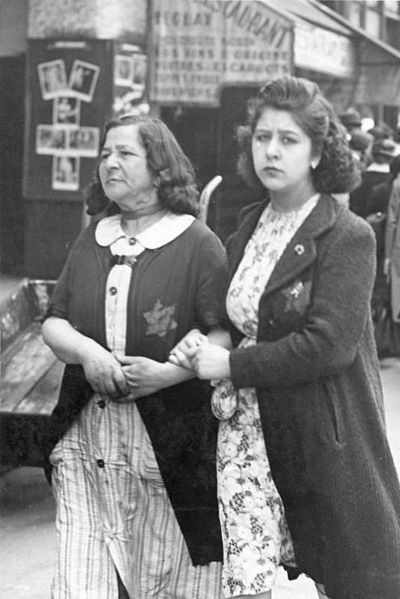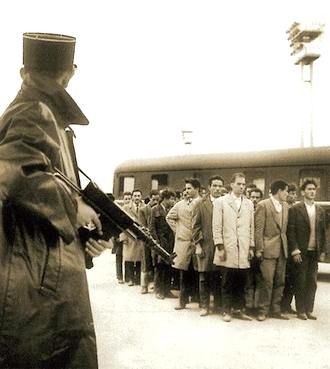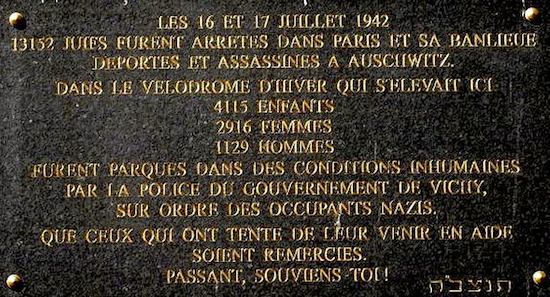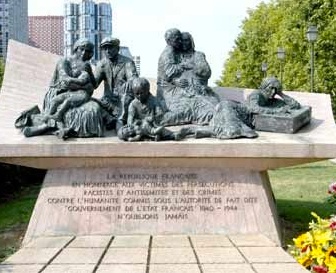Des Jours de la Honte: Days of Shame at Vel d’Hiv

- SUBSCRIBE
- ALREADY SUBSCRIBED?
BECOME A BONJOUR PARIS MEMBER
Gain full access to our collection of over 5,000 articles and bring the City of Light into your life. Just 60 USD per year.
Find out why you should become a member here.
Sign in
Fill in your credentials below.
 I’m standing on rue Nélaton at the corner of rue Nocard in the 15th arrondissement in Paris. Just across the street is a building housing the Interior Ministry, one of those nondescript office buildings put up all over the city starting in the late 1950s.
I’m standing on rue Nélaton at the corner of rue Nocard in the 15th arrondissement in Paris. Just across the street is a building housing the Interior Ministry, one of those nondescript office buildings put up all over the city starting in the late 1950s.
Rue Nélaton is a fairly typical street, part residential, and part commercial, in this part of town. Buildings are a bit more spread out in this area than in the more central parts of the city because until the 1960s large-scale development, such as the Front de Seine, hadn’t yet begun. So this sparsely populated area was home to a large sports venue, the Vélodrome d’Hiver, or Vé l d’Hiv (winter cycling stadium). It was just another sports arena. That is until July 1942 when it was commandeered by the French police and used as a holding pen for over 13,000 Jewish men, women and children before they were shipped to various labor and death camps throughout France and other parts of Europe.
The year 2011 marks the 69th anniversary of La Grande Rafle du Vél’ d’Hiv, the name given to the main round-up of Jews in Paris. During this mass arrest, most of the adults were sent directly to the transit camp at Drancy, outside Paris, while parents with children were taken to the Vél d’Hiv. Beginning on July 15, 1942 and for the next two days, the French police canvassed the city with buses, picking up Jews and taking them to the stadium.
 Conditions inside the Velodrome were horrific—the heat was relentless, there were no toilets, little water or food, and no place to sleep. For six days the helpless prisoners endured fear, panic and physical humiliation while the French police stood by. After all, they were just following orders. Or were they?
Conditions inside the Velodrome were horrific—the heat was relentless, there were no toilets, little water or food, and no place to sleep. For six days the helpless prisoners endured fear, panic and physical humiliation while the French police stood by. After all, they were just following orders. Or were they?
When Germany invaded France in 1940, less than a year after the start of World War II, France was divided into two zones: occupied and unoccupied. Unfortunately, that proved to be a distinction without a difference for Jews in France. While part of France was indeed unoccupied by the Germans, it was under the governance of the collaborationist Vichy regime under Marshal Philippe P étain, a hero of the World War I. As president of the Vichy regime, P étain sent Jews to the 200-plus concentration camps within France on his own initiative, and he drafted and published anti-Jewish laws before his German partners requested. In occupied France, which included Paris, French authorities took it upon themselves to ask the Germans if they could arrest Jewish children in addition to adults.
Of the more than 13,000 Jews arrested and imprisoned at the Vél d’Hiv, only 400 survived the concentration camps and just 25 returned to France at war’s end.
It is a distressing coda to this shameful episode that most French have no idea that there were concentration camps in their country because La Grande Rafle and other atrocities have been all but ignored by the school system. Fortunately though, history has been coming out of the darkness through novels such as Sarah’s Key by Tatiana de Rosnay and films like La Rafle by Rose Bosch.
 The Vélodrome d’Hiver was demolished in 1958 and in July 1994 the Place des Martyrs Juifs du Vélodrome d’Hiver was dedicated at the intersection of quai de Grenelle, quai Branly and boulevard de Grenelle. In 1995 President Jacques Chirac was the first Frenchman to acknowledge France’s complicity in the unspeakable crimes against the Jews of Europe during World War II.
The Vélodrome d’Hiver was demolished in 1958 and in July 1994 the Place des Martyrs Juifs du Vélodrome d’Hiver was dedicated at the intersection of quai de Grenelle, quai Branly and boulevard de Grenelle. In 1995 President Jacques Chirac was the first Frenchman to acknowledge France’s complicity in the unspeakable crimes against the Jews of Europe during World War II.
Toni Kamins has spent decades living, studying, visiting, and traveling in France. She is recognized as a Jewish history expert and most recently she published France’s Muslim Question in BonjourParis.
PHOTO CREDITS:
All photos public domaine except:
Paris, Jüdische Frauen mit Stern
(Paris, Jewish women with stars)
ADN-ZB II. Weltkrieg 1939-45 Frankreich unter der Besetzung der faschistischen deutschen Truppen, Anfang Juni 1942. Ab 1. Juni 1942 werden auch in Frankreich die Juden gezwungen, den gelben Stern zu tragen. UBz.: zwei jüdische Frauen in Paris. 3627-42
More in 15th arrondissement, French history, history, Jewish, Jewish history, Jewish Martyrs statu, Jewish Paris, Nazi history, Paris history, Place Martyrs Juifs, Vel d'Hiv, velodrome, Vichy, WWII


